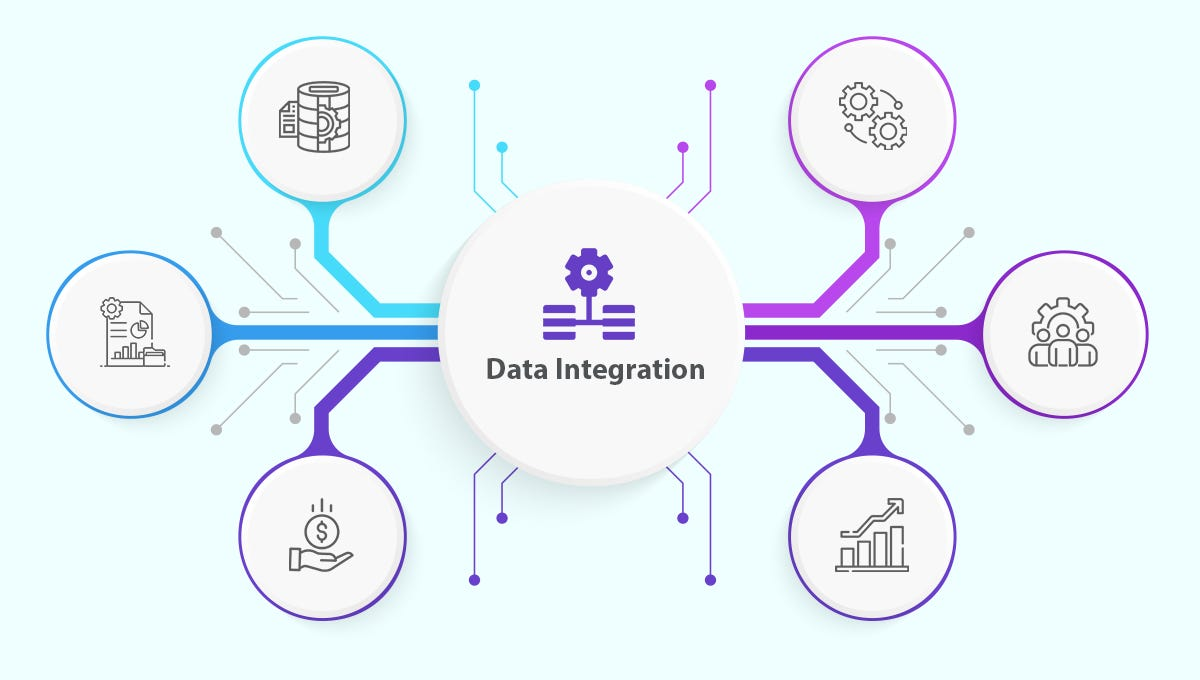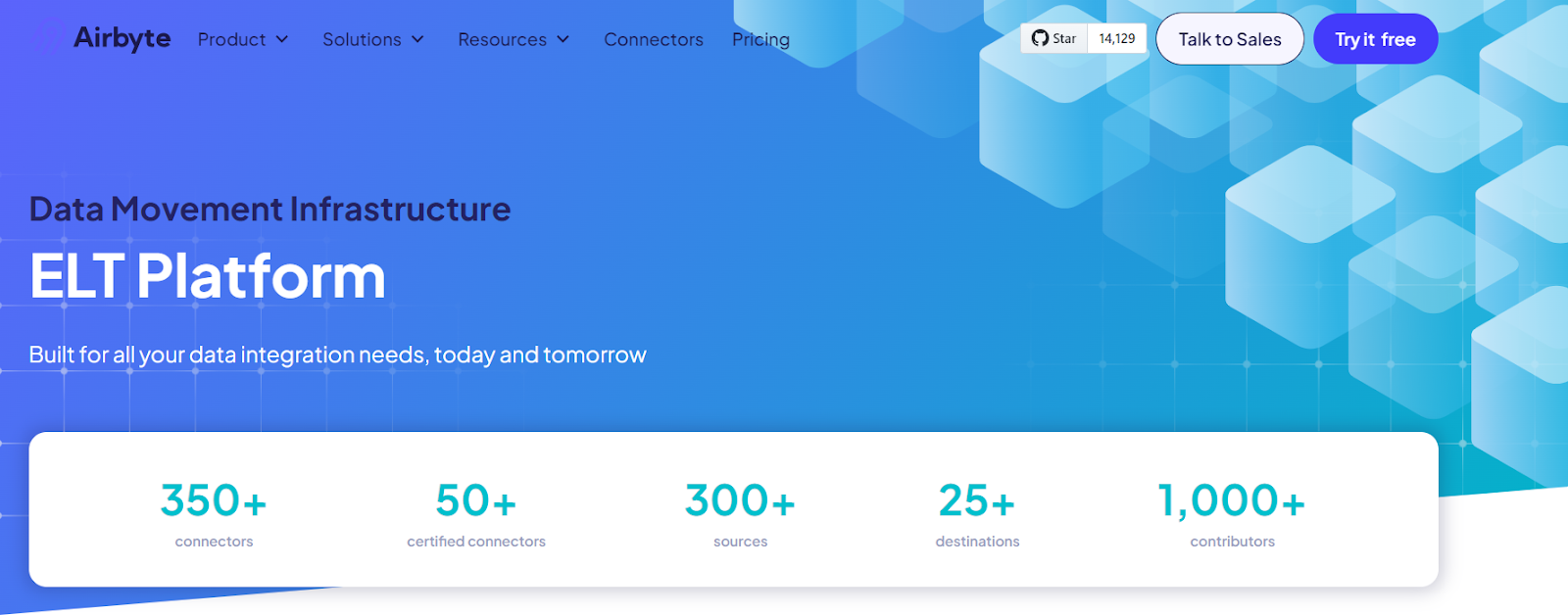6 Data Integration Challenges & Solutions You Should Know
Summarize this article with:
✨ AI Generated Summary
Data integration consolidates data from multiple sources into a centralized system, enabling unified insights and improved decision-making. Key challenges include handling large data volumes, ensuring data quality, managing diverse formats, minimizing collection delays, resolving compatibility issues, and maintaining security.
- Solutions involve scalable storage (data lakes/warehouses), data cleansing, format standardization, real-time data replication, technology audits, and secure platforms with encryption and compliance.
- Platforms like Airbyte offer flexible, scalable integration with features such as Change Data Capture, developer-friendly tools, support for various data types, custom transformations, and robust security measures.
Organizations today are flooded with substantial data volumes from diverse sources, such as financial records, CRM data, survey reports, and transactional systems. While this data holds a lot of potential, it also poses significant challenges when it comes to integrating it for easy storage, retrieving, and analysis. This is where data integration steps in.
However, integrating data isn’t always achieved without a hitch. This article will delve deeper into the six most common data integration challenges you might face, along with the solutions to overcome them.
What is Data Integration?

Data integration is the process of consolidating data from multiple sources into a centralized repository to gain a unified view of your data. You can gather data from various sources, such as SaaS applications, databases, or on-premise systems. Once the data is collected, you can load them into a destination like a data lake or warehouse.
Data integration gives your enterprise a comprehensive view of customer data, key performance indicators, and other aspects of business operations. By observing these metrics on a single platform, you can formulate effective strategies, improve operational efficiency, and build a scalable business model.
Types of Data Integration
There are several techniques to perform the data integration process. Some of them include:
- Extract, Transform, Load: ETL is a popular data integration method that involves extracting data from various sources and performing transformations to ensure the data is compatible with the destination system. Once the data is cleansed, it is loaded into a target system.
- Extract, Load, Transform: ELT is another integration process in which the sequence of the last two steps is reversed. The data is gathered from multiple sources and loaded into a destination system. After data loading, the transformations are performed on the datasets whenever required.
- Change Data Capture (CDC): This method facilitates real-time or near-real-time data integration. You can effortlessly capture changes from the source data and replicate them into the destination since the last integration. Using this approach, you can efficiently replicate data across systems to keep your data in sync.
6 Data Integration Challenges and Solutions
Let’s take a look at some of the most prominent data integration challenges and solutions:
Dealing With Large Data Volumes
Challenge: As your organization continues to grow, it deals with a large amount of data from diverse sources. This makes the process of data consolidation very complex since big data can overwhelm traditional integration methods. In such a scenario, it delays the processing time, causes data loss, and increases resource utilization.
Solution: To efficiently store large datasets, you must find a suitable and scalable storage system like a data lake or warehouse. These systems help you handle the storage issue of expanding datasets.
After storing your data in an appropriate destination, you can also utilize modern data management platforms to maintain and manage your dataset. These platforms are equipped with automated data control, distributed storage, and parallel processing features.
Data Quality Issues
Challenge: Maintaining data quality becomes challenging when data originates from multiple sources, each with specific standards. This can lead to several quality issues, such as missing values, errors, misspellings, incorrect formatting, or incorrect entries. These issues, in turn, provide inaccurate data, which leads to false inferences and poor decision-making.
Solution: To address these concerns and achieve high-quality data, it is imperative to implement data cleansing and validation methods. As soon as the data is collected, verify it for errors or discrepancies before integrating it into the system. This ensures that your integrated data is reliable and of high quality.
Diverse Data Formats
Challenge: Data comes in disparate formats, such as relational databases, Excel, CSV, or JSON files. Unifying this data can make data integration difficult due to formatting variations. This can lead to processing challenges and inconsistent datasets. Consequently, redundant data storage can occur if the same information is stored in different formats, leading to financial and storage loss.
Solution: To overcome this problem, you must standardize data formats across your enterprise. This involves defining common formats for data elements. You can also employ data transformation tools to help you modify data into a predefined and consistent format.
In addition, you can utilize data-wrangling tools designed to format data across several platforms into a single, usable base language. These tools help transform raw data into insightful knowledge.
Data Collection Delays
Challenge: Delays can disrupt business operations that depend on real-time or near-real-time data collection. Integrating data as and when generated can be arduous, as it requires data to be collected and loaded quickly. Therefore, without a strong data integration strategy for managing your dataset, you will face difficulty improving your decision-making.
Solution: To avoid this situation, you can leverage ingestion solutions with data replication capabilities. These solutions allow you to identify and capture data from the source and replicate it effortlessly in the target system. This helps you track data easily and maintain sync between source and destination systems. You can also utilize streaming processing techniques to process data as it is generated. These techniques enable you to deal with large data volumes, empowering you to draw actionable insights.
Compatibility Issues
Challenge: Data integration is a continuous process, which means that it requires compatibility between the systems and technologies involved. When your team works with different systems tailored to fulfill specific requirements, it results in a disparate data structure. This can give rise to various issues, such as incompatibility between source and destination systems.
Solution: To address these problems, you should first conduct a detailed technology audit to ensure that different systems are in sync. Performing this step plays a vital role in saving time and IT resources for other projects.
Security Risks
Challenge: Maintaining the security and privacy of data is one of the other issues with data integration. As your organization consolidates large, diverse data, it becomes prone to security breaches and cyber-attacks. This is particularly true when integrating data from various sources, which may follow necessary safety laws and regulations. Therefore, it is imperative to protect sensitive data to maintain your stakeholders' trust.
Solution: Choose a secured data integration platform that offers end-to-end data security solutions and performs real-time monitoring to track and prevent unauthorized access. The platform must be equipped with advanced data masking techniques such as tokenization, encryption in transit, and at rest for PII protection. It should also comply with security certifications such as FDPR, CCPA, or HIPAA to ensure best industry practices.
Benefits of Data Integration
Integrating data from multiple sources in a single location offers various benefits, such as:
Improved Data Quality
Data integration helps you to improve the quality of your dataset. Various data integration tools have built-in data quality solutions to cleanse your data. Several quality issues, such as missing entries, errors, or inconsistent values, are resolved during the transformation process. This helps you build confidence in your data and perform seamless analytics.
Better Decision Making
Consolidating data from multiple sources gives you a unified view of your data. It reduces data redundancy and allows your team to use accurate and consistent datasets. Having access to this data enables you to identify new trends, discover past patterns, and make informed data-backed decisions.
Boost Productivity
With data integration, you can increase the productivity of your enterprise by automating manual tasks such as data entry, transfer, or cleaning. You can employ integration tools to reduce data silos and simplify workflows effortlessly. This lets you spend less time on repetitive or redundant tasks and focus on drawing useful insights from your dataset.
Cost Efficient
Data integration solutions offer long-term savings and higher profitability, surpassing the initial expenditure. When data is combined into a single system, the costs associated with running and maintaining several databases are reduced. This lowers the cost of infrastructure, employee training, and system licensing.
Overcome Data Integration Challenges With Airbyte
Till now, you have seen some of the major data integration challenges and the appropriate solutions to tackle them. One of the most crucial steps in resolving such challenges is to use a dynamic platform that caters to your integration needs. With Airbyte, you can leverage streamlined data integration as it offers flexible and scalable solutions.

Introduced in 2020, Airbyte is a robust cloud-native data integration platform that allows you to effortlessly extract data from disparate sources and load it into a centralized repository. With its rich library of 350+ pre-built connectors, you can quickly build data pipelines without writing a single line of code. If you can’t find a connector of your choice, you can create custom connectors using CDK or request a new one by contacting its sales team.
Beyond integration capabilities, Airbyte also leverages the support of a vibrant community of 15000+ members. These members consist of data practitioners and developers actively involved in maintaining its open-source environment. You can also engage with others to discuss best integration practices, share articles or resources, and resolve issues in data ingestion.
Let's see how Airbyte helps you address Data Integration Challenges:
- Data Replication Capabilities: Airbyte offers Change Data Capture functionality, which enables you to identify changes in the source file and replicate them in the target system. This helps to keep your data in sync across systems.
- Developer-Friendly UI: It offers an open-source library, PyAirbyte, for Python users. This library facilitates extracting data from Airbyte-supported connectors within your Python workflows.
- Handle Different Data Types: With Airbyte, you can quickly adapt to modern integration requirements as it supports data sources that contain semi-structured, unstructured, and structured data.
- Custom Transformation: To execute advanced data transformations, you can integrate Airbyte with dbt. This enables you to manage your transformation according to your needs, thereby ensuring a seamless workflow.
- Security Features: To safeguard your data from external access, Airbyte employs various security features. These measures include regular security assessments, encryption in transit, access control, audit logs, and credential management.
Final Words
This article has comprehensively discussed the data integration challenges and solutions, along with detailing their importance and benefits. Dealing with large and diverse datasets presents various challenges, like compatibility issues with storage systems, quality issues, and security risks, which restrict your business to scale. However, by leveraging the flexibility of integration solutions, you can store data efficiently, perform seamless analytics, and develop optimized workflow.
Frequently Asked Questions
Who needs data integration?
Any organization that aims to organize, analyze, and process data must leverage data integration. The integration process involves seamless data collection, archiving, storage, and retrieval.
What is the advantage of data integration?
Data integration facilitates easy data transfer across multiple platforms and systems. This reduces data silos, fosters accurate decision-making, and enhances teamwork.
How to choose a data integration tool?
There are various factors based on which you can choose a suitable data integration tool. These include diversity in pre-built or custom connectors, support for sources and destinations, security and compliance, and ease of use.
What are the factors affecting data integration?
The factors affecting the complexity of a data integration environment include the diversity of sources, technologies employed, data quality, specific needs of the business, and the scope of integration.
Suggested reads: Healthcare Data Integration

.png)